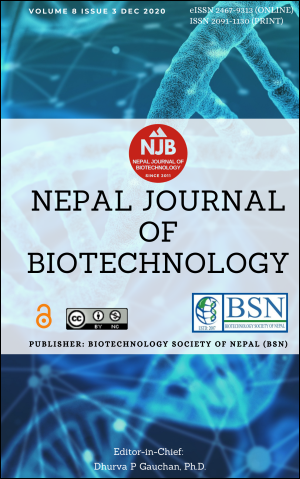Biofuel Production from Waste Cooking Oils and its Physicochemical Properties in Comparison to Petrodiesel
DOI:
https://doi.org/10.3126/njb.v8i3.33661Keywords:
Waste cooking oils, Transesterification, FTIR spectra, Methyl ester, BiodieselAbstract
Haphazard mining and consumption of fossil fuels have reduced petroleum reserves causing fossil fuel depletion and environmental degradation; thus, reflecting the need for the cheaper, renewable and eco-friendly alternative source of petroleum to meet the fuel demand. A million liters of edible oil used for cooking foods and date expired oils from oil manufacturers are discarded into sewage. This study primarily intends to study the feasibility of biodiesel production using such waste oils. In this work, biodiesel was prepared from waste cooking oils by a process called transesterification with NaOH as a catalyst. Our results showed that methyl ester (biodiesel) (92.67±0.90%), soap materials (1.33±0.224%), and glycerol (6±0.68%) were obtained after the transesterification of waste cooking oil. The physicochemical properties of biodiesel such as density, viscosity, volatility, surface tension, and flashpoint were analyzed, which were found to be 0.862±0.006 g/cm3, 2.23±0.021 cP, 0.327×10-3±4.5×10-6 g/s, 32.03±0.138 dyne/cm, 169.67±0.810°C, respectively. These properties were compared with that of commercial diesel as well as with the values specified by the American Society for Testing and Materials (ASTM) D6751. The density and the surface tension of the biodiesel were found similar to that of petrodiesel but its volatility was 3 times lower. Fourier-transform infrared spectroscopy (FTIR) spectra of the biodiesel showed methyl ester functional group at 1436 cm-1. Based on the cost of the materials used for production, the cost of biodiesel was estimated to be about 81 Nepalese rupees (0.67 USD) per liter. The properties of biodiesel also met the standard values of ASTM D6751. These findings indicate that waste oil is one of the feasible biodiesel sources and it can be used as a suitable alternative to petrodiesel.
Downloads
Downloads
Published
How to Cite
Issue
Section
License
Copyright Notice:
The manuscript submitted to NJB must be an original contribution, not previously published and should not be under consideration for publication elsewhere. When the manuscript is accepted for publication, the authors agree to automatically transfer the copyright of the article to the publisher. It should grant permission to any third party, in advance and in perpetuity, the right to use, reproduce or disseminate your article, according to the NJB copyright and license agreement.
Authors transfer copyright to the publisher as part of a journal publishing agreement but have the rights to: Share their article for Personal Use, Internal Institutional Use and Scholarly Sharing purposes, with the NJB applies the Creative Commons Attribution-NonCommercial CC BY-NC license to all the works we publish after Jun 2020 (Before it was CC BY-NC-ND). Under this license, authors agree to make articles legally available for reuse, without permission or fees, for virtually any non-commercial purpose. Anyone may remix, adapt, and build upon your work non-commercially, and although their new works must also acknowledge you and be non-commercial, they don’t have to license their derivative works on the same terms. More details on CC BY-NC refer to its Licence Deed and Legal Code.






